Options offer investors powerful tools to generate income from their investments. Selling options allows investors to collect premiums by taking on defined risk. With the right strategies, options can be used to produce monthly, quarterly, or even weekly income streams.
This guide will discuss 10 of the best options and income strategies for generating consistent cash flow. We will cover multiple strategies including covered calls, cash-secured puts, collars, calendar spreads, and more. Each strategy profiled offers different risk-reward characteristics. Some aim to enhance dividend yields, while others focus on capitalizing on volatility. All are proven methods that professional traders employ to earn premiums on a regular basis.
Mastering options is not as difficult as many assume but does require diligent study. This overview of popular income strategies is meant to introduce core concepts and pique your interest in further exploring these tools; by understanding how each function works, you can determine which best aligns with your risk tolerance, time horizon, and portfolio objectives. Making just one or two trades per month using the right strategy can meaningfully boost your investment income.
1.Covered Calls
Covered calls is an options trading strategy where an investor writes (sells) call options on an asset that they already own. Call options work when an investor agrees to sell the underlying asset to the buyer of the call at a predetermined strike price any time before the option expires.
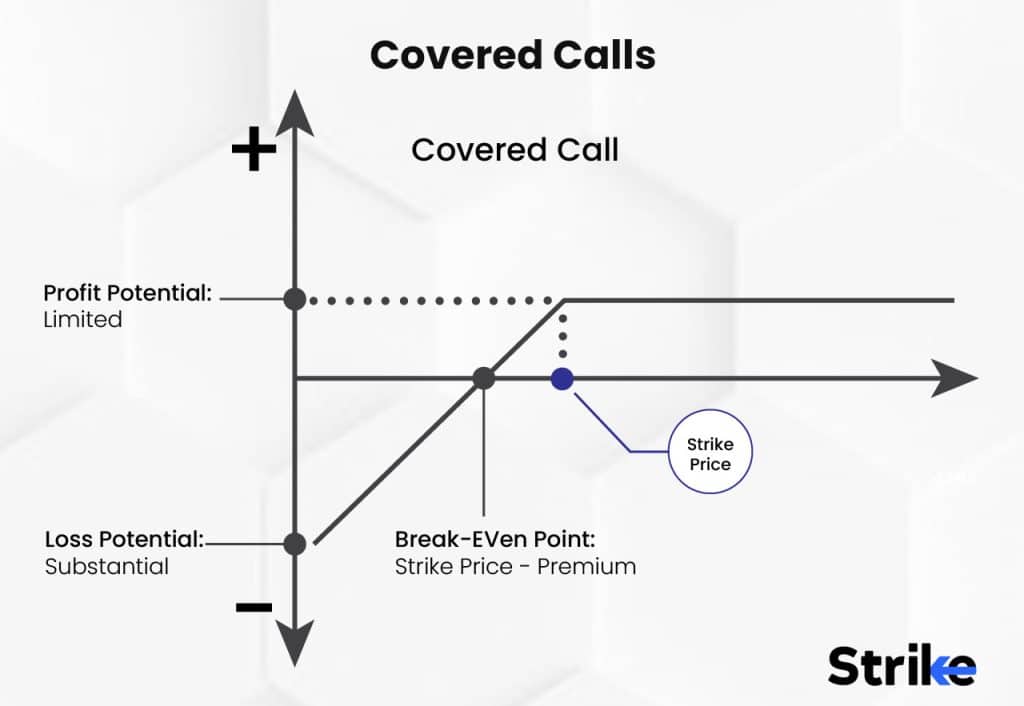
The investor must own an equivalent amount of the underlying asset to cover the number of call options written for this strategy to be “covered.” This is done to limit downside risk since if the call is exercised, the investor covers it by selling the shares. The key benefit is that the investor receives immediate cash income from premiums generated by selling the call options.
The maximum profit is achieved if the price of the underlying asset does not reach the strike price by expiration and the call expires worthless, allowing the investor to keep the premium. The maximum loss would occur if the price rises significantly above the strike price, forcing the investor to sell the shares at the lower strike price. However, the loss is limited to just the difference between the market price and strike price, plus fees.
For example, an investor holds 100 shares of stock currently trading at Rs 50. They sell 1 1-call contract with a strike of Rs 55 that expires in 1 month for a Rs 2 premium. Their maximum profit is Rs 200 (premium received). Their break even is Rs 52 (strike + premium). Their maximum loss is selling at Rs 55 even if the stock rises above. Overall, it provides income potential with limited downside risk.
A benefit of covered calls is it allows investors to generate income from stocks they already own. There is a chance that selling at the strike price will eliminate any gain potential if the share price climbs above it. Perfect timing is also required to exit before expiration for maximum profit.
2. Iron Butterfly
An iron butterfly is a neutral options strategy that is designed to profit from implied volatility remaining high or decreasing through the expiration date. It involves holding both a bull call spread and a bear put spread simultaneously on the same underlying asset.
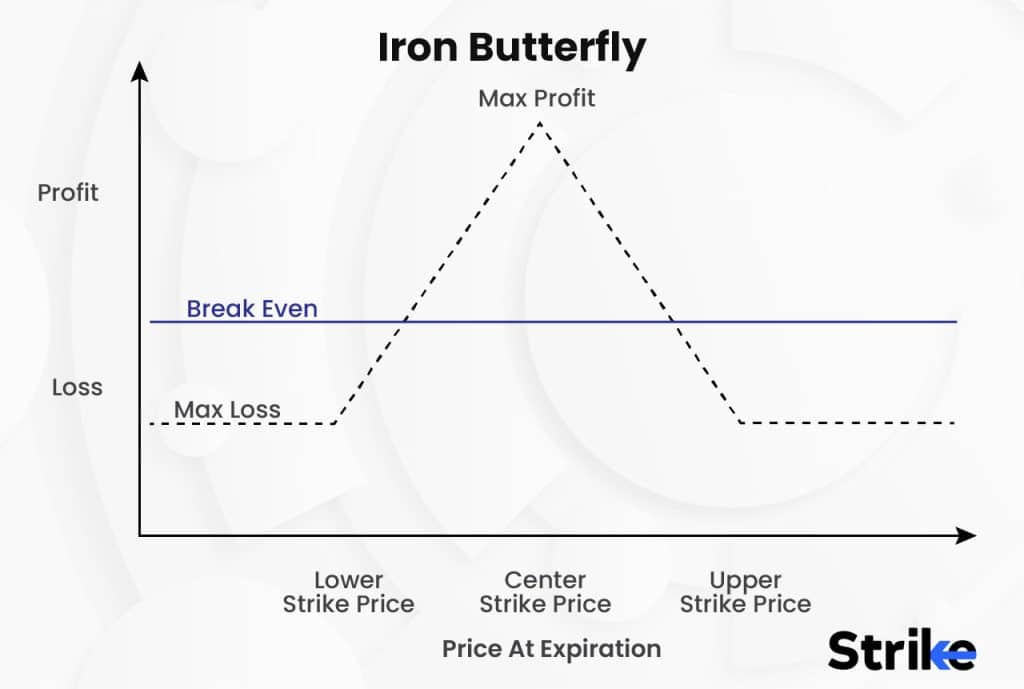
The Iron Butterfly is a neutral options strategy that aims to profit from implied volatility remaining high or decreasing through expiration. It involves entering both a bull call spread and a bear put spread simultaneously on the same underlying asset.
An at-the-money (ATM) call is sold, while an out-of-the-money (OTM) call with a higher strike price is bought to enter an iron butterfly. Simultaneously, an ATM put is sold while an OTM put is bought with a lower strike price. The OTM calls and puts comprise the “wings” that define the maximum profit and loss zones for the position.
Maximum profit is realized if the underlying asset closes within the wings at expiration. This occurs if implied volatility remains elevated or declines as expected, allowing time decay to increase the position’s value. Maximum loss results if the asset expires below the lower put wing or above the higher call wing due to a sharp, unexpected move.
The iron butterfly’s profit potential is limited, but so too is its risk. The cash required is restricted to the net premium received when opening the position. Profits are realized primarily from the passage of time if the asset stays between the wings until expiration. However, large, rapid movements cause maximum losses to be realized. Proper positioning of the wings manages this risk profile for steady premium collection.
Some benefits are that it allows profits from either a flat or narrowly ranging market. Dimensioning the wings properly defines the limited risk. Rolling is done to adjust the position for continued time premium collection.
However, this strategy performs poorly if volatility increases substantially or the market makes a strong directional move outside the wings. The breakeven range is also narrow, requiring precise execution.
For example, an investor enters an iron butterfly on Stock XYZ trading at Rs 50 with strikes at Rs 50/Rs 52/Rs 48. Net credits are Rs 0.50. Profits are realized between Rs 48-52 at expiration due to time decay; otherwise, a maximum loss of Rs 0.50 is faced.
The iron butterfly generates steady income but requires skill and conditions to remain neutral for success over time. Its non-directional nature makes it suitable for some market environments.
3. Iron Condor
An iron condor is a neutral options strategy that profits from low volatility and share price stagnation. Iron Condor strategy involves simultaneously entering both a bull put spread and a bear call spread on the same underlying asset.
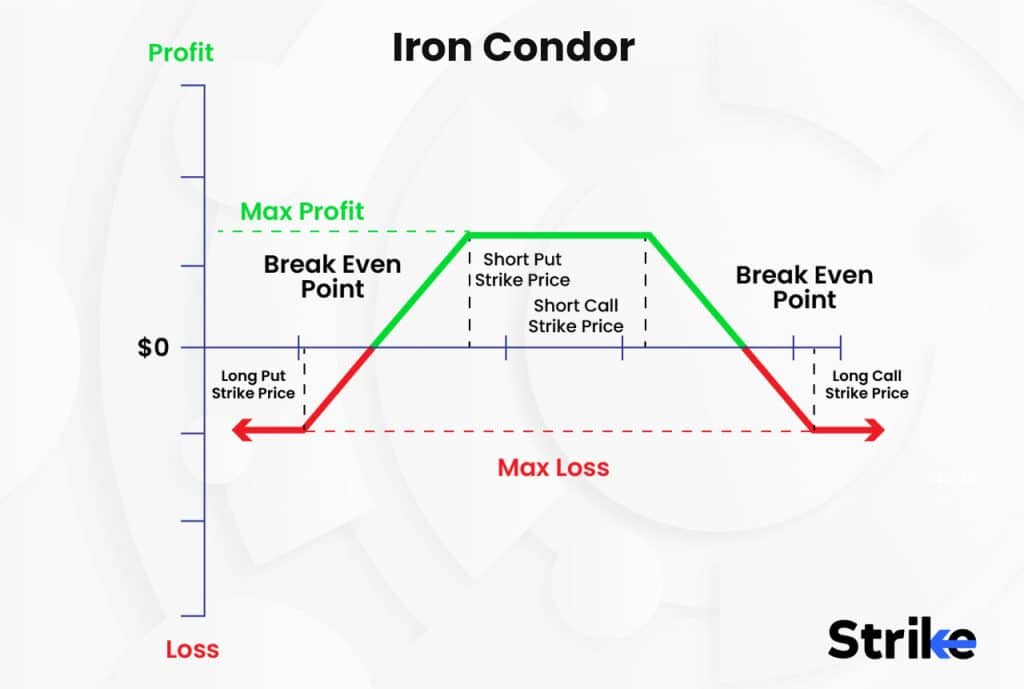
The iron condor is a neutral options strategy that profits from low volatility and a lack of significant price movement in the underlying asset. An investor will simultaneously enter both a bull put spread and a bear call spread on the same asset to establish an iron condor position.
This involves selling an at-the-money (ATM) put and call while purchasing further out-of-the-money (OTM) puts and calls at closer strike prices. The strikes between the sold and purchased options define the maximum profitable price range for the position.
The iron condor profits primarily from the passage of time as options decay and approach expiration within this narrow range. The maximum gain is limited to the premium received when opening the position.
However, maximum loss occurs if the underlying asset experiences a decisive move outside of the defined profitable range before expiration. Such an unexpectedly large movement would cause the short options to be tested, eliminating the time premium earned.
The cash required to enter an iron condor is restricted to the margin needed to support the widths between strikes of the long and short options within the spreads. This limited risk profile makes the strategy appealing for neutral market views.
An iron condor profits from time decay if the asset remains between the strike prices. The narrower the profitable range, the higher the probability of success but the lower the maximum gain.
Benefits include collecting premium income over multiple expiration cycles. Potential profits are locked in early by closing certain wings. Researching historical volatility helps dimension optimal payoff levels.
However, sharp, unexpected moves against the position results in maximum losses being realized. The strategy also underperforms in strongly trending markets.
For example, an investor enters an iron condor on Stock XYZ at Rs 50 with a Rs 48 put, Rs 52 call, Rs 46 long put, and Rs 54 long call. If XYZ closes between Rs 46-52, the Rs 0.50 net credit is kept. Outside this range, a Rs 0.50 loss occurs.
The iron condor profits consistently in low volatility environments but requires skill to avoid losses from wrong directional assumptions. Overall, though, its flexible, limited-risk construction benefits neutral strategies.
4. Straddle Option
A straddle is a non-directional options strategy that profits from a large increase in the underlying asset’s implied volatility. It involves simultaneously holding both a call and put option with the same strike price and expiration date.
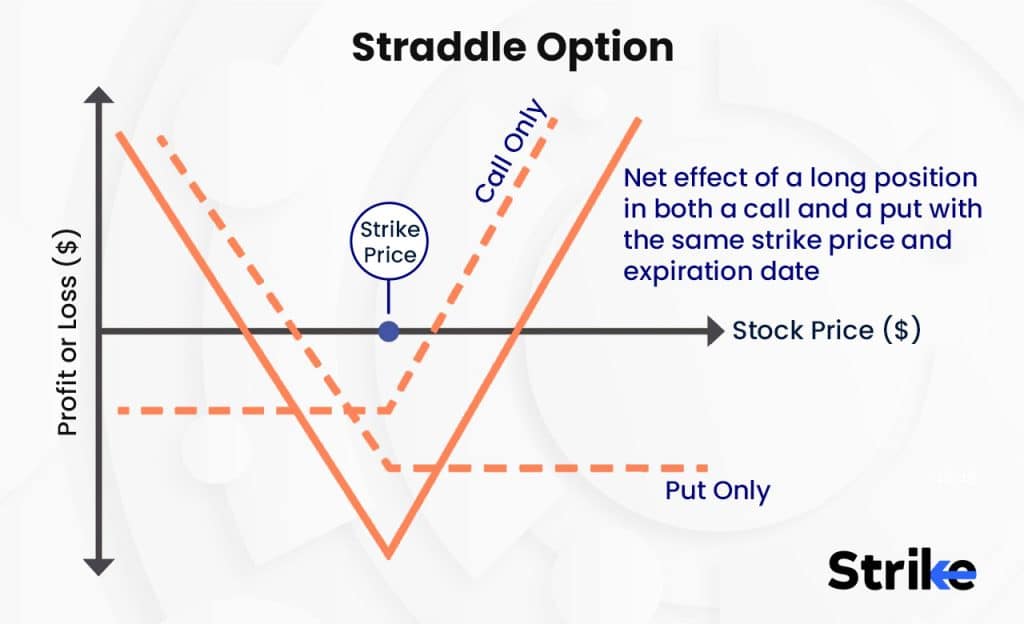
A straddle is a non-directional options strategy that aims to profit from an expansion in the underlying asset’s implied volatility. An investor will purchase an at-the-money (ATM) call and put options that both have the same strike price and expiration date to establish a straddle position.
The straddle has unlimited profit potential by holding both a call and put option simultaneously since there is no ceiling to how high or low the underlying asset’s price can sometimes move by expiration. The maximum loss, however, is clearly defined as the total debit price paid to establish the position.
The breakeven points are calculated as the strike price plus or minus the net premium amount paid. This establishes the price thresholds that must be surpassed by expiration for the time decay value lost to be recouped.
The cash required equals the total outlay to purchase the call and put options used given the large move required. This represents the maximum defined risk if volatility fails to increase as anticipated and time value erodes. Overall gains are optimized if volatility expands rapidly.
A straddle benefits from large quick movements since increased volatility will raise both option values. It profits whether the move is up or down sharply.
Advantages include its unlimited gain potential. Taking a view on volatility rather than direction also provides different exposure.
However, it requires a decisive move just to break even. Time decay hurts as expiration neaRs if the asset trades sideways. Proper anticipation of volatility is key.
For example, an investor buys an ATM Rs 50 straddle for Rs 5 on Stock ABC. Profits start above Rs 55 or below Rs 45. A move past Rs 50.05 or Rs 49.95 by expiration yields profits due to volatility expansion offsetting time decay.
Overall, the straddle fills a role for playing big moves but carries drawbacks if volatility declines or the asset simply trends modestly in one direction.
5. Strangle Option
A strangle is a non-directional options strategy that profits from an increase in the underlying asset’s implied volatility, similar to a straddle. However, it uses options with different strike prices rather than the same strike.
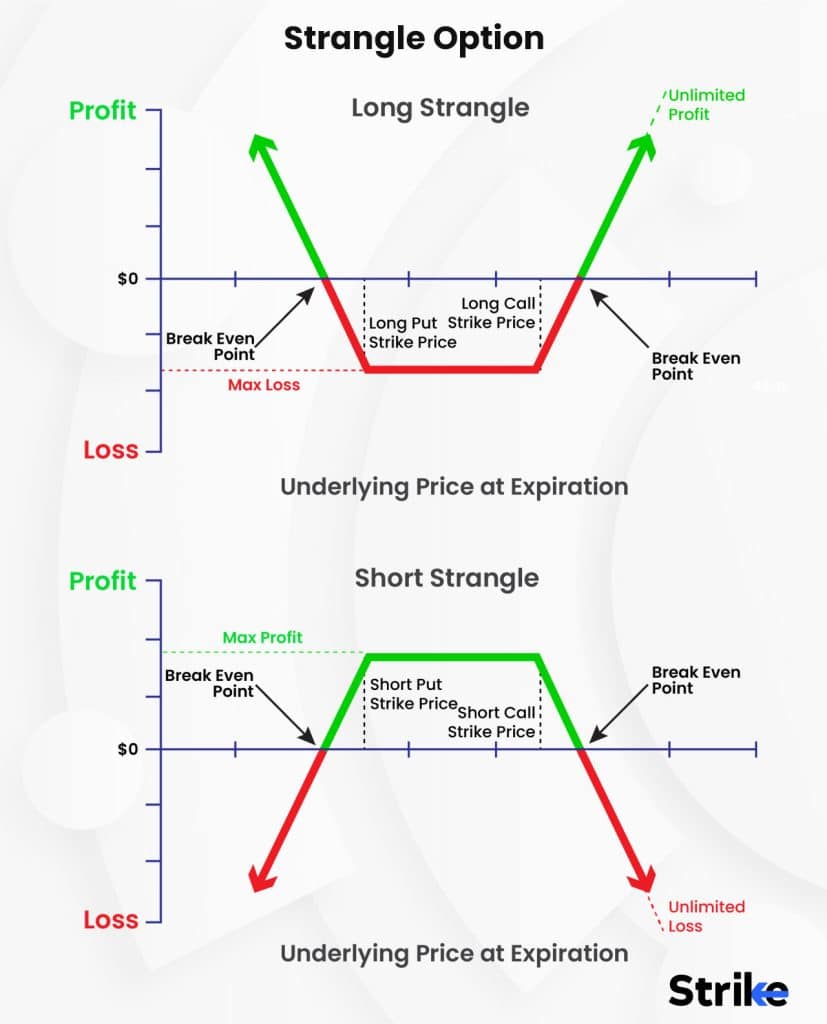
A strangle is a non-directional options strategy similar to a straddle but has the advantage of requiring less cash to establish the position. An investor will simultaneously purchase an out-of-the-money (OTM) call and put an option on the same underlying asset to create a strangle.
Using OTM options lowers the total net premium needed compared to a straddle, which uses at-the-money options. The maximum profit potential of a strangle remains unlimited, similar to a straddle, as there is no limit to how high or low the asset’s price moves.
However, the maximum loss is clearly defined and capped at the total debit amount spent to enter the trade. Since the call and put will have separate strike prices due to being OTM, they will also have different breakeven thresholds based on these individual levels.
A strangle needs less cash upfront than a straddle due to the lower premium OTM options required. This makes the strategy more accessible while still providing exposure to upside or downside moves in the asset through a single, defined risk position. Like a straddle, unlimited gains are achieved if volatility increases sharply in one direction.
Like a straddle, a strangle benefits from sharp volatility expansion, either up or down. However, the OTM strikes provide more time for this to occur before expiration.
Advantages include requiring less capital due to using OTM options. Breakeven points are also optimized for the viewed scenario.
However, the asset still needs to experience a significant move through at least one strike price just to break even. Time decay additionally challenges profits the longer a quiet market persists.
For example, an investor buys an ATM Rs 50 strangle with a Rs 55 call and Rs 45 put for a Rs 2.50 net credit. Profits start on moves above Rs 57.50 or below Rs 42.50, with gains increasing exponentially above those thresholds.
6. Put Credit Spread
A put credit spread, also known as a bear put spread, is a limited-risk options strategy that profits from stock either rises in price or stays the same. It involves selling a put option at one strike price while simultaneously purchasing a put at a lower strike price on the same stock.
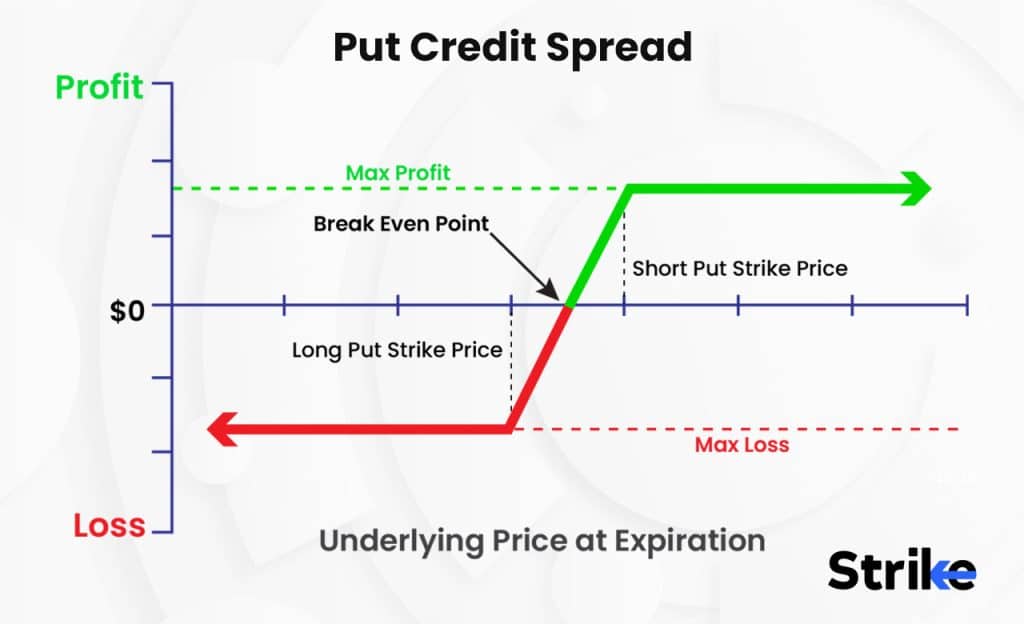
A put credit spread is a limited-risk options strategy that profits from a stabilization or rise in the underlying stock price. An investor will short an at-the-money (ATM) or out-of-the-money (OTM) put option and use the premium collected to purchase a further OTM put with a lower strike price to open the position.
The maximum profit is clearly defined and capped at the total net credit received from establishing this spread. In contrast, the maximum possible loss is equal to the difference between the short and long put strikes minus the initial net credit.
The breakeven price is calculated as the strike of the short put minus the total opening net credit. Margin requirements are reduced compared to shorting a put outright by holding the longer put.
Less cash is needed upfront since the long put partially offsets the margin required for the short put. Time decay will realize the maximum profit potential as the put options expire worthless if the underlying stock stays above the short put’s strike price. Overall, the spread structure limits risk in favor of premium collection.
A put credit spreads profits as time decays if the stock stays above the short put strike. The premium collected exceeds the cost of the long put if it expires worthless.
Benefits include limited risk from capping losses. Downside protection exists until the shortcut is tested. Multiple spreads are layered for greater income.
However, losses mount quickly if the stock drops below the short put strike. The early assignment is also possible if deep ITM. Proper sizing and volatility evaluation are critical.
For example, an investor enters an ABC Rs 50-Rs 45 put credit spread for a Rs 1 credit. Maximum profit is Rs 1, and loss is Rs 4 if ABC < Rs 45, and breakeven is Rs 49 at expiration. The downside is defended to Rs 50 while collecting time premiums.
7. Call Credit Spread
A call credit spread, also known as a bear call spread, is a limited risk options strategy that profits from stock either decline in price or remain stable. It involves selling a call option at one strike price while simultaneously purchasing a call at a higher strike price on the same underlying stock.
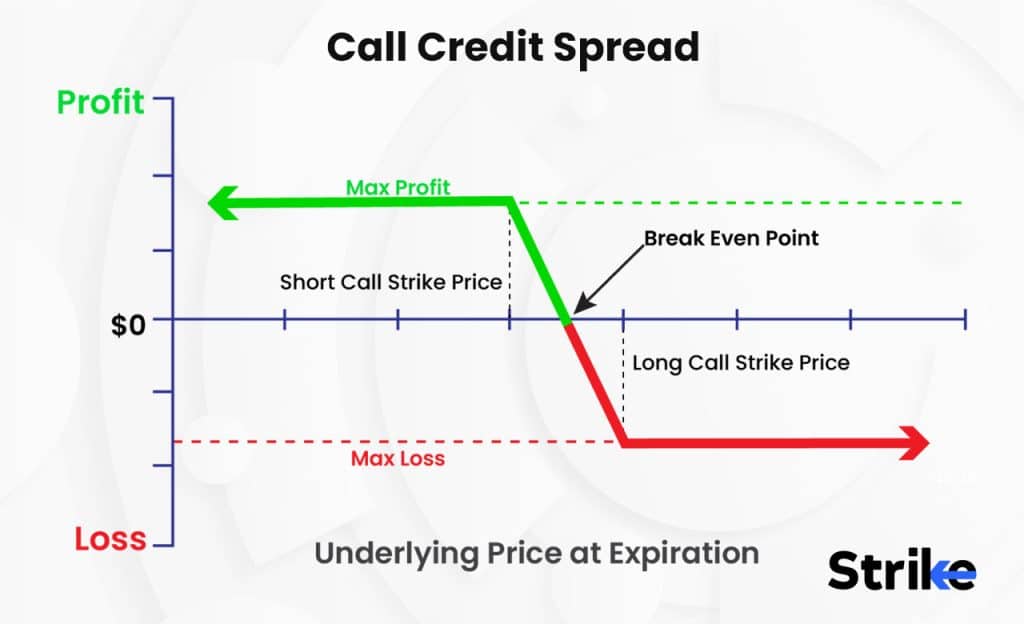
A call credit spread is a limited-risk options strategy that profits from a stabilization or decline in the underlying stock’s price. It is established by shorting an at-the-money (ATM) or out-of-the-money (OTM) call option and using the proceeds to purchase a further OTM call with a higher strike price.
The maximum profit potential is clearly defined and capped at the total net credit collected when opening this call spread position. In contrast, the maximum possible loss is equal to the difference between the call strikes minus the initial net credit amount.
The breakeven stock price is calculated as the strike of the short call plus the total opening net credit received. Less cash is needed upfront versus shorting a naked call since the long call partially offsets the margin requirement imposed on the short call position.
Time decay will realize the maximum profit as the options expire worthless if the underlying stock remains below the short call’s strike price. Overall, the spread structure provides participation in downside moves while clearly defining potential risks for this limited-risk strategy.
A call credit spread profits from time decay if the stock stays below the short call strike at expiration. The premium collected exceeds the long call’s cost if it expires worthless.
Benefits include defined risk parameters. Multiple spreads can be layered for greater returns. Early assignment on the short call is unlikely if OTM.
However, the upside is capped. Losses accelerate if the stock rises above the short call strike. Evaluating volatility and probability of success is important.
For example, an investor enters an XYZ Rs 55-Rs 60 call credit spread for a Rs 1.50 credit. Maximum profit is Rs 1.50, and loss is Rs 3.50 if XYZ > Rs 60, and breakeven is Rs 56.50. Upside participation is restricted to Rs 55 while collecting time premiums.
8. Protective Collar
A protective collar is an advanced options strategy that aims to limit downside risk on an appreciated long stock position while allowing for some continued upside participation. It works by simultaneously using a covered call and a protective put.
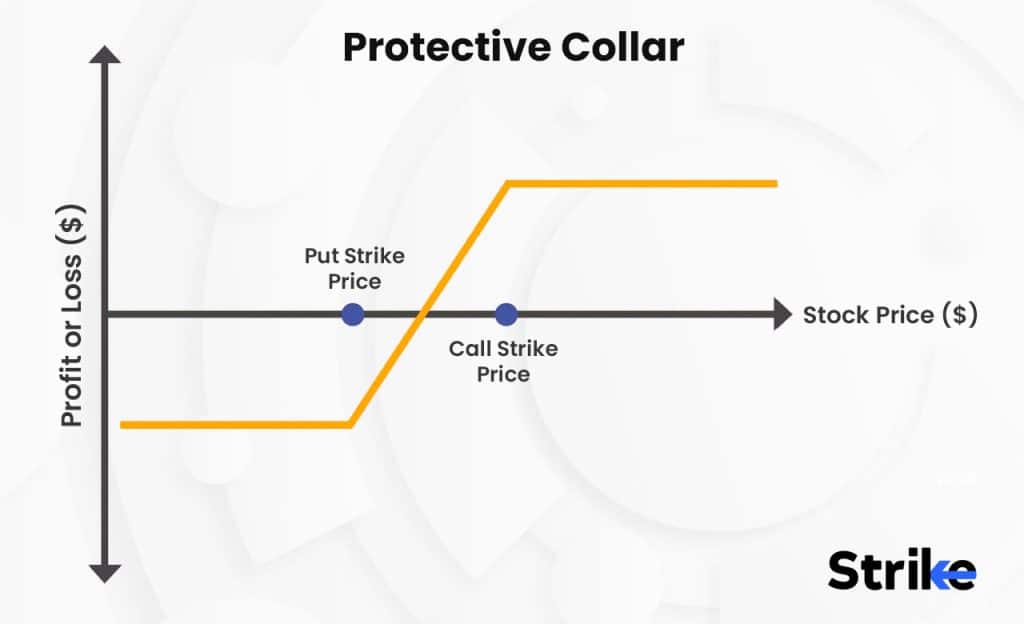
The protective collar strategy aims to limit downside risk on an existing appreciated long stock position. An important aspect of this strategy is that the investor already holds the stock. A covered call is then sold from this position, with a strike price set slightly above the current stock price.
Selling this call option allows the investor to generate premium income. The premium collected from entering the covered call is then used to purchase long-dated put options on the same stock. However, the put options purchased act as protection and have a lower strike price than the short call.
It defines the stock’s risk window for the investor by establishing the call and putting positions simultaneously. The short call caps upside potential at its strike price plus the premiums received. Meanwhile, the long puts insulate the downside by protecting the investment to the put strike minus the premium spent. This provides a balanced way to mitigate risk on the appreciated stock holding.
This defines the stock’s risk window. Maximum profit is capped by the short call strike plus premiums. The downside is protected by the put strike minus premiums paid.
The most common is for the short call strike to be within 5% of the stock price and the put 10-15% lower. This provides a buffer to let volatility fluctuations be profited from.
Benefits include participating in further upside moves. The downside is insulated from short-term volatility. The premium income helps lower the cost basis.
However, the calls can be exercised, limiting the upside at that strike. Extended sideways periods erode profits from time decay. Lower strikes forfeit participation in larger moves.
For example, an investor with XYZ at Rs 100 sells Rs 105 calls and uses the Rs 3 premium to buy Rs 90 puts. Potential profits range from Rs 95-Rs 105, with the downside protected to Rs 87. Seasoned traders use this strategy effectively to mitigate risk.
9. Married Puts
A married put is an options strategy used to hedge downside risk on a stock holding. It works by purchasing long-term put options and holding them simultaneously with an equivalent number of shares in the underlying stock.
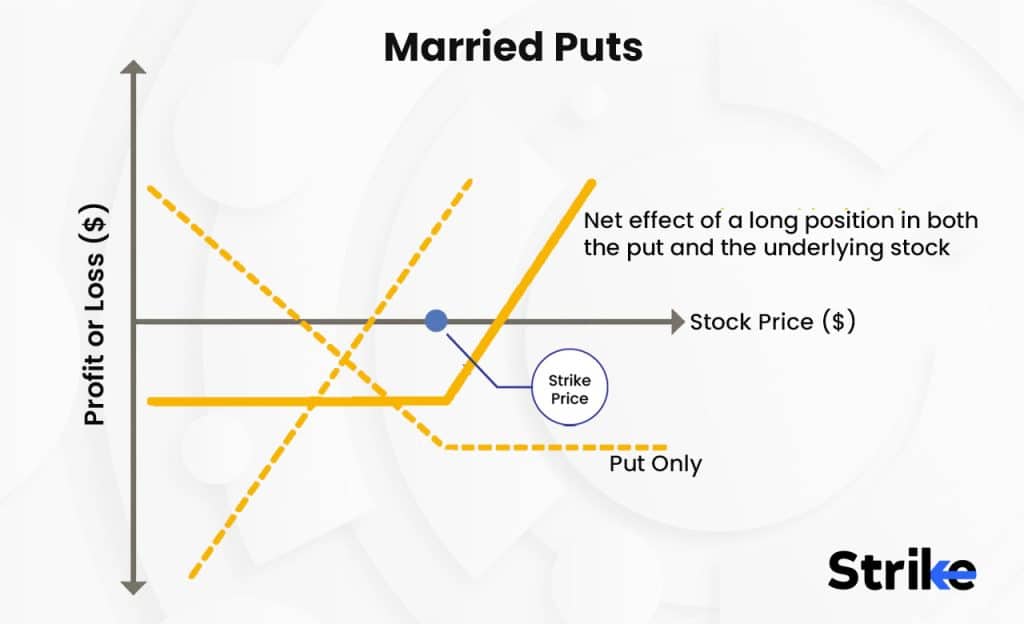
A married put strategy is used to hedge downside risk on an existing stock holding in an investor’s portfolio. An important aspect is that the investor already owns 100 shares of a stock. Long-dated put options that cover the same 100 shares of that underlying stock are then purchased to employ this strategy.
It provides downside protection for the investor’s stock holding at the strike price of the put contract by purchasing these put options. The maximum profit potential comes from the stock appreciating in price above the original purchase level plus any remaining time value held by the put options.
The maximum possible loss is clearly capped at the net premium that was paid to purchase the protective put options. The breakeven point is calculated as the cost basis of the shares held minus the premium amount used to enter the put position.
This married put structure allows the stock position to benefit from upside moves while mitigating downside risk, as the put contracts insulate losses below their strike price. It effectively hedges potential losses on an existing bullish stock holding.
Married puts protect the stock from declines, mitigating investment risk. Profits continue above the strike once the protection is surpassed.
Benefits include defined risk parameters and participation in appreciation. The downside is safeguarded for long-term buy-and-hold scenarios.
However, an opportunity cost exists to hold unleveraged stock. Time decay hurts longer-term put values. Lack of dividends diminishes total returns versus stock holding alone.
For example, an investor buys ABC at Rs 50 per share and then purchases 1-year Rs 50 puts for Rs 3 each. Protection is guaranteed to Rs 47. They profit from gaining participation with advances over Rs 53. The downside is capped to preserve capital.
10. Cash Secured Puts
A cash-secured put is a conservative options strategy where an investor sells or “writes” put options on a stock they are willing to own in order to generate income. It requires the trader to set aside enough cash in their account to purchase the stock at the put’s strike price if assigned.
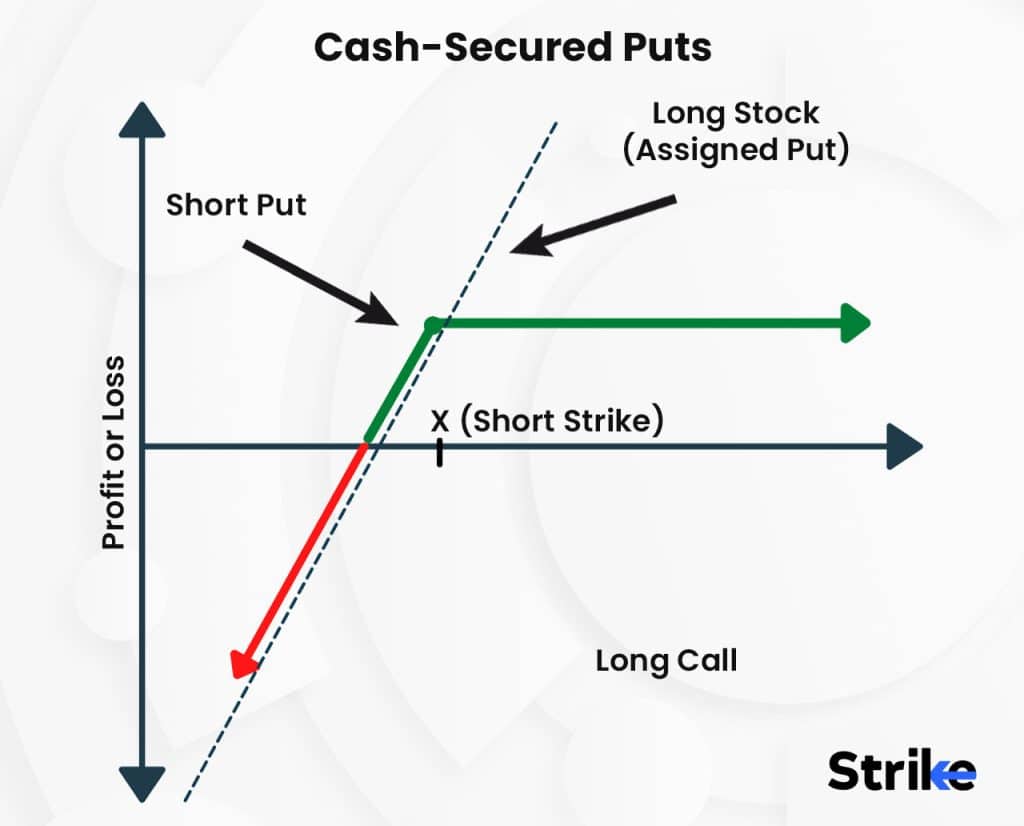
A cash-secured put strategy generates income by selling put options while taking a bullish view of an underlying stock. An important aspect is reserving enough cash in the trading account. Specifically, an amount equal to the put strike price multiplied by 100 shares per contract must be set aside.
Put options are then written with a strike price below the stock’s current market value with the cash set aside. Selling these puts allows the investor to collect premium income. The maximum profit is realized if the stock remains above the put strike at expiration and the options expire worthless.
However, there is the risk of assignment if the stock price drops below the put strike before expiration. The maximum possible loss, In this case, is capped at having to purchase the shares for the strike price.
The breakeven point on the stock price is calculated as the strike minus the put premium received per share. This defines the level at which the premium collected offsets the cost of stock acquisition if assigned. Overall, the cash-secured requirement ensures funds for stock purchase while collecting option premiums.
Writing cash secured puts off steady income from the premium collection while reserving an entry point into a desired stock. Assignment results in purchasing the stock at the chosen strike, which is viewed as favorable.
Benefits include insight into stocks favorable for long-term ownership. Downside participation also continues if the share price drops.
However, funds are tied up until expiration. But the tradeoff is collecting premiums for assuming this obligation.
For example, an investor sells 3 ABC Rs 50 puts for Rs 1.50 per share in premium. Maximum profit is Rs 450 (3 x 100 shares x Rs 1.50). The downside is the assignment to buy 300 shares of ABC at a Rs 50 cost basis.
What is an Options Income Strategy?
An options income strategy is an investing approach that aims to generate consistent cash flow by selling options contracts on a regular basis.
More specifically, an options income strategy involves using option premium selling techniques like covered calls, cash-secured puts, or bull/bear credit spreads to collect premiums in return for taking on a certain amount of risk. Selling options allow an investor to earn income from the premiums received upfront from the buyer while capping their upside potential or taking on downside risk in the underlying stock or ETF.
The goal of an options income strategy is to earn premiums on a recurring basis through options expiration cycles. An investor potentially collects steady monthly or weekly income that exceeds the dividends paid by buy-and-hold stock positions by employing various limited-risk options trades that have a high probability of expiring worthless.
Done effectively with the right asset selection, strike pricing, and trade adjustments over time, an income options strategy provides a cash flow stream that aims to supplement income from other sources like a job, rental properties, pensions, or social security. The steady premium selling allows for a degree of budgeting and planned cash generation through different market conditions.
How do Income Strategies differ from Options Strategies?
Income strategies focus on generating regular income through options, while options strategies employ various option combinations to profit from different market conditions. Options income strategies differ from other options strategies in their overall goals. The primary aim of an income strategy is to generate consistent cash flow through the collection of options premiums on a regular basis. Other options strategies focus more on achieving capital appreciation in the underlying asset.
The risk profile of income strategies also distinguishes them. Income strategies commonly employ lower-risk options trades like covered calls, cash-secured puts, and credit spreads to favor high-probability trades that are opened and closed frequently. This is in contrast to other strategies that take on more risk in their positioning in pursuit of larger upside potential returns.
The timeframe of each trade is also different. Income strategies are designed for harvesting premiums on a recurring, scheduled basis, such as monthly or weekly. This requires trades to be established and exited within weeks or months. Other options and strategies could take a longer-term view and hold positions for multiple expiration cycles.
Additionally, income strategies require a different approach to position sizing. They favor initializing many smaller positions scaled to each individual trade to allow for multiple concurrent trades. Conversely, some options strategies employ concentrated, larger bets on fewer underlying assets.
Another distinguishing factor is the level of discipline required. Strict management and adherence to trade guidelines are necessary for an income strategy to realize profits regularly. Other strategies permit more flexibility on adjustments or exiting trades.
Lastly, income strategies best suit investors seeking additional sources of steady cash flow. Their goal of frequent, predictable premium generation aligns well with income needs. However, options strategies focused on capital returns are more appropriate for objectives like wealth accumulation or speculation.
How to Choose the Best Option Income Strategy?
Choose the best option income strategy by assessing your risk tolerance, capital requirements, market outlook, and desired cash flow to select a strategy that aligns with your overall investing goals and suits the current market environment.
The first step when selecting an options income strategy is to evaluate your individual risk tolerance, time horizon, and income needs. Strategies involving covered calls or cash secured offer relatively low risk and are well-suited for generating steady monthly cash flow. However, they require active management as trades progress. Spreads provide higher premiums but involve taking on greater risk through their multi-leg positions. Consider which type of risk and time commitment aligns best with your situation.
It’s also important to test different underlying assets that could form the basis of an income strategy. Stocks, ETFs, and indices all behave uniquely and provide different income opportunities depending on implied and historical volatility levels. You will be able to identify which pair well with your preferred approach and market views by researching how option strategies have performed using various underlying strategies. Diversifying across asset classes and sectors also helps reduce reliance on any one position being correct.
Focus on smaller trade sizes when starting out to practice different strategies on a more manageable scale. Paper trading is also wise to understand order execution nuances without risking capital initially. Monitor key metrics like fill rates, win percentages, and average returns to optimize your strategy over numerous trade cycles. Tracking performance helps determine which variables to adjust, such as strike prices or position sizing.
You will be able to take on somewhat larger positions with experience while still adhering to sound risk management and trade discipline. Rigorous planning through indicators like setting profit/loss targets in advance allows capturing premiums consistently to meet your specific income objectives over time. Ongoing education and adapting to different market environments also ensure choosing the most robust long-term income strategy.
What is the best Option Income Strategy for BeginneRs?
The best income strategy for beginner options traders just becoming acquainted with premium selling is writing cash-secured puts. Put writing introduces the fundamental mechanics of options in a stable, low-risk manner suitable for novices.
Selling cash-secured puts requires minimal technical analysis skills while offering built-in risk management. Traders simply choose a stock they’d be willing to own at a target price and collect a premium by putting it up for sale. Losses are capped at holding the stock long-term if assigned because the put is covered by cash.
This clearly defined risk makes it attractive for beginners. Put writing, unlike directional plays, profits whether the underlying stock moves up, down, or sideways over weeks. Traders focus on premium harvesting as the main income source. Outcomes are often known within 1-3 months, providing quicker feedback than buy-and-hold positions.
Historical data also shows puts have a high probability of expiring worthless, allowing traders to simply keep the premium. This consistent premium realization builds confidence for novices without needing precise market or volatility timing abilities.
Puts also don’t require large portfolios for diversification. Traders write across several stocks with only a few thousand dollars of settled cash. This early access to a working options strategy motivates learning without delay.
Puts forgive minor analytical mistakes compared to riskier plays. Rather than amplifying losses, mistakes only mean holding an intended long-term investment somewhat early. The downside is entirely finite and known upfront.
In essence, writing’s gentle learning curve, built-in limiting of risks, emphasis on premium collection over direction, and portfolio flexibility make it uniquely well-suited as beginners cut their teeth on option selling. No other strategy so smoothly introduces premium selling concepts for novices seeking practical experience. For building fundamental options without understanding, cash-secured puts stand out as the top choice.
What is the best Option Income Strategy for Experts?
The best strategy for experienced options traders to generate substantial income is the use of tailored multi-leg spreads and combinations. Expert traders have the technical analysis and timing skills to construct sophisticated non-directional positions benefiting from various pricing anomalies.
Experts unlock richer premium opportunities compared to simpler strategies by designing unique spread configurations. Advanced traders understand different option behaviors under different implied volatility environments and for distinct market cycles. They exploit these phenomena through custom asymmetric plays.
For example, broken-wing butterflies profit handsomely from implied volatility contractions without needing a stock move. Diagonal spreads capture time premium on top of directional bets. Collars employ covered calls and protective puts to generate high income with limited risk. Iron condors and strangles also produce outsized gains from panic pricing overreactions.
The flexibility of tailored spreads allows experts to craft positions benefiting from multiple monetization angles simultaneously. Well-structured combos realize income from time decay, mean reversion, volatility compression, and directional bias – whichever is present first.
Expert traders also understand leveraging live markets dynamically. Positional adjustments overnight radically alter structured spreads’ risk/reward in their favor. Roll-ups, roll-downs, and ratio change profit from secondary pricing anomalies uncovered.
Few other strategies allow such calibrated precision or scale. Experts build five-way combinations synthesizing any desired payoff using the front month against back months. Outcomes are rarely binary, instead exploiting nuanced perf deviations.
Adjustments recapture slippage while building new positions for steady compounded harvesting. Experts fine-tune positions for immediate gain or multi-month management, seamlessly appropriating outcomes to needs.
What is the best Option Income Strategy for Swing Traders?
The best option strategy for swing traders to generate consistent income is selling cash-secured put spreads. Put spreads involve selling puts at one strike price while buying protective puts further out of the money for a limited, defined risk. They require less capital than naked puts and suit swing trading time frames better.
Cash-secured put spreads allow swing traders to benefit from directional moves within a targeted range over periods of weeks to months. Premium collection rates average around 30-50% of spread width each month held by selecting strikes reasonably but not far out of the money. This steady premium flow is well-aligned with swing trade holding periods.
The contained risk window between strikes gives put spreads their profitability edge. Historical data shows gains realized over 70% of the time as positions simply expire worthless. Profits are usually known within the targeted swing trade timeframe of several weeks to a couple of months or less.
Put spreads have a much higher probability of profit due to their minimized risk zone in comparison to other limited risk strategies. Rarely do both legs get hit for maximum loss, whereas probabilities strongly favor keeping the premium in most cases.
Put spreads also carry fewer capital requirements than naked puts. This allows scaling into multiple overlapping positions across different securities. Gains then compound exponentially from continuous income generation within planned swing trade windows. Continuous rolling reinvests premiums for snowball profits.
Additionally, put spreads allow diversifying capital across many options positions. This grants greater flexibility to adjust exposures than concentrated stock picks alone. Spreads likewise mitigate sequencing risks of whipsaw price moves exiting and reentering individual names.
What is the best Option Income Strategy for Day Traders?
The best options strategy for day traders to generate consistent income is selling condor spreads. Condor spreads involve selling both put and call options at multiple strike prices to benefit from contracting volatility. They provide an ideal risk-defined structure for capturing short-term premium decays suitable for the day trading timeframe.
Condors allow day traders to profit whether markets move up, down, or sideways within the limited risk boundaries defined by the strikes. Premium collection rates average around 50% of spread width each week by selecting strikes just out of the money. This steady flow of premium income makes condors extremely attractive for day traders seeking to augment profits from other short-term stock/futures positions.
The concentrated risk zone between the strikes gives condors their profitability edge for day trading. The spread premiums will decay predictably each session if volatility contracts as implied. Daily profits compound from repeated bouts of theta gang harvesting over positions held just days to weeks maximum by scaling into many condors across different underlying.
Condors have a much higher probability of profit due to their limited risk design in comparison to other short-dated option strategies. Outcomes are often known within a couple of weeks, fitting perfectly into day trading time frames. Seldom do all legs execute for a maximum loss, whereas probabilities favor keeping the majority of the premium in most cases.
Studies show condors realize gains over 70% of the time on average. Such consistent profit realization from repeated premium harvesting is immensely valuable for active day traders. Gains compound exponentially from continuous income generation within short-span windows.
Additionally, condors are one of the few income option strategies suitable for regulated pattern day trader rules due to their sub-Rs. 1 premium widths. This allows rotating in and out of multiple positions each day for repeatedly doubling smaller profits. Condors enable day traders to minimize risk yet massively scale their gain potentials by opening multi-leg spreads as premium selling vehicles.
What is the most profitable Option Income Strategy?
The most profitable option strategy for generating income is selling covered calls. Studies have shown it has significantly boosted returns over the long haul due to high compounding effects, while covered calls provide steady premium income from month to month.
Selling covered calls is highly profitable due to capitalizing on two sources of return – stock ownership and call premiums. Investors collect income from accepting the obligation to sell shares they already own at a preset strike price. It is simply called away for a guaranteed instant profit equal to the difference between the cost basis and strike if the stock rises above the strike. But typically, the options expire worthless, and both the shares and premiums are kept for another month of income.
Over time, the compounding impact of these monthly cash flows leads to exponential growth of total returns. Even modest incremental gains of just 3-5% per year have enormous effects when repeated for decades. Backtesting data shows covered call funds routinely outperforming plain stock indexes by this margin every cycle. The doubling of investment periods is reduced, allowing portfolios to reach the same value levels years faster.
Perhaps most valuable is that covered calls remain profitable regardless of market conditions. Ranging markets allow selling deep-in-the-money calls to collect over 1% monthly on blue-chip stocks. Bull markets let the underlying stock appreciation provide returns, while capped upside from calls is merely a bonus. Bear markets see premium flows continue and limit the downside by owning the underlying equities.
Diversification is also easier than naked options due to buying stocks first before calls. Margins of error are greater as declines are waited out instead of needing to close losing positions. Proper analysis of historical volatility and option pricing further stacks the statistical edge to retain 85%+ of premiums collected over time.
Overall, no other income strategy has demonstrated the same risk-adjusted, persistent ability to compound wealth through various cycles like covered calls. The reliable supplementary returns above dividend stocks alone have reliably increased total profits by hundreds of percentage points over decades of bull and bear markets. Covered call writing continues to stand apart as the most lucrative income generator available for investors focused on profitability.
What is the most successful Option Strategy for Income?
The most successful options strategy for consistent income generation is the covered call strategy. An investor sells call options against shares of a stock already owned in their portfolio with covered calls. This allows them to collect premium income while holding the underlying investment.
Covered calls are widely considered the most successful income strategy for several key reasons. Firstly, the historical probability of profit is extremely high at over 70% on average. The worst that happens is the options expire worthless, and the premium is kept since the calls are covered by owning the underlying stock. The position is simply repeated to generate premiums month after month with the stock still owned.
This consistent repeatability is a major advantage over other strategies. Selling covered calls provides reliable supplemental income without needing to accurately predict market moves or hold positions for extended periods. New call options are sold each month on the same stocks. This compounds premium income over time at a far greater pace than passive dividend investing alone.
Studies have shown that covered calls increase total returns in a portfolio by 3-5% annually on average by harvesting premiums this way. Over decades of compounding, this has the potential to significantly boost overall portfolio value and allow for a more successful retirement. The steady premium cash flow also provides greater income stability versus keeping funds in lower-yielding savings accounts.
Furthermore, covered calls are suitable for almost any market environment. Premiums are collected as options decay toward expiration in sideways or mildly bullish markets. But the upside is simply capped at the call strike for a profit if stocks break out higher. And declines are offset by owning the shares. This flexibility and adaptability means covered calls continue generating income whether markets rise, fall, or move sideways.
Covered calls give investors greater confidence their capital will remain protected in comparison to riskier strategies. The premium income is essentially found money on top of already owning quality stocks. Losses are limited as long as proper hedge ratios and strikes are employed. Overall, the risk-adjusted returns provided by covered calls have led to it being perhaps the most consistently successful income strategy available over the long run.
Versatility across different market conditions, and risk-adjusted returns, covered call writing stands out as a premium income generator when evaluating success based on historical profitability. The tendency for high probabilities of profit, repeatability, and downside protection are major reasons it frequently outperforms alternatives as a steady long-term income investment strategy.
What is the safest Option Strategy for Income?
The safest options strategy for generating income is selling cash-secured puts. An options trader sells put options with this strategy and collects premiums while taking on the obligation to buy the underlying stock at the strike price if assigned. However, the trader minimizes risk by having enough cash in their brokerage account to cover purchasing the stock at the strike price.
Selling cash-secured puts is considered the safest strategy because it has defined risk and income potential. The maximum possible loss is capped at keeping the cash deposited until expiration. Even if the stock price falls below the put strike, the trader simply uses the cash to buy the shares at the negotiated put strike rather than the lower market price. Their downside is limited to the secured cash amount in this way.
Additionally, the premiums collected from selling puts provide a consistent income stream with a high probability of profit. The options will expire worthless most of the time, and the trader keeps the full premium. Historical data shows over 80% of cash-secured puts are not assigned. So, sellers have a very strong chance of simply pocketing the premiums without ever having to buy the underlying stock. This steady income generation makes cash-secured puts appealing for generating yields on idle cash.
Compared to other strategies like naked options or spreads, cash-secured puts have a built-in margin of safety. The cash deposited acts as a buffer absorbing any losses from stock moves below the put strike up to the secured amount. There is less risk of losses spiraling or facing assignment on a position that will not be able to be adequately funded. The downside is finite and quantifiable from the start as long as the proper cash amount is secured.
What is the riskiest Option Strategy for Income?
The riskiest option strategy for generating income is selling naked calls. With this strategy, an options trader sells call options contracts without owning the underlying stock. This allows the trader to generate income from the premiums received from the sales. However, it also exposes the trader to unlimited risk.
Selling naked calls is considered the riskiest because there is no upside limit to how much could be lost. The trader’s maximum possible loss as the seller of a call is unlimited since the stock price could, in theory, continue rising indefinitely. The naked call seller is obligated to fulfill their side of the contract no matter how high the stock moves, by delivering the shares at the strike price if assigned. This means that losses surpass the initial premiums received. A trader could end up owing much more than they expected or be able to afford an unlimited downside if the stock moves strongly against their position.
In contrast, other options strategies like covered calls or cash-secured puts have built-in risk management due to limiting factors. The downside is capped because the stock is owned to cover assignments with covered calls. The margin required limits losses to the amount deposited with cash-secured puts. But selling naked calls carries derivative risk since it is an obligation without an asset to back it up. There are no buffers to prevent limitless losses from an adverse stock move in excess of the strike price.
Additionally, naked calls are risky because the trader is betting solely on the direction of the stock. Unlike other strategies, there is no edge related to volatility or expiration timing effects. The trader is simply making a directional wager with nothing to offset being wrong other than the premiums received. Any unforeseen announcements or events causing a sharp move against the position to pile on losses exponentially. Overall, the risk-reward profile is severely skewed towards risk when selling uncovered calls due to having unlimited exposure with just premiums to gain.
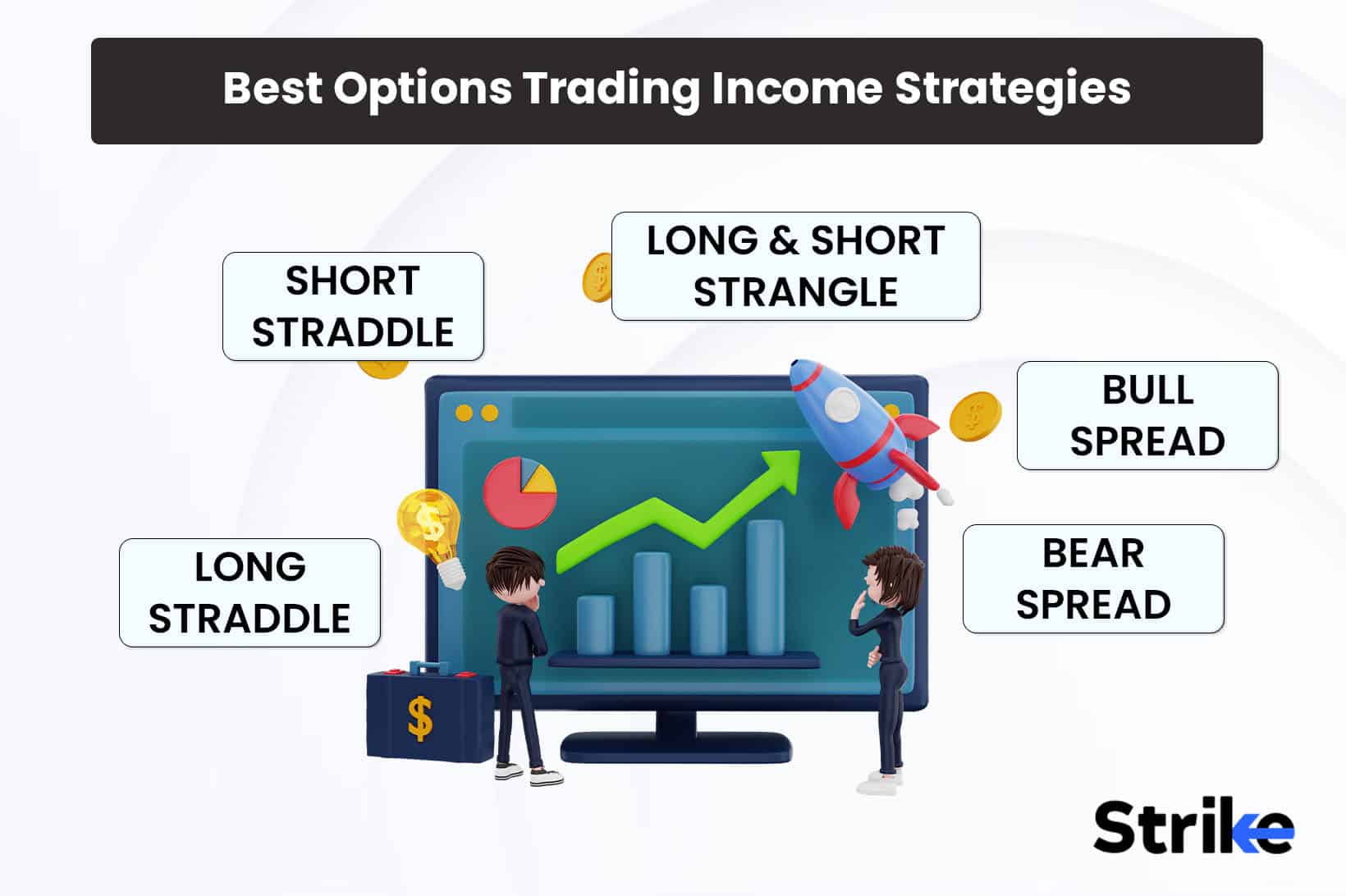





 Previous Article
Previous Article






No Comments Yet